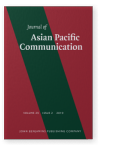Vol. 29:2 (2019) ► pp.168–187
Comparative rhetoric and emic approaches to Chinese persuasive strategies in hotel discourse
Many studies concerning culture and rhetoric have been restricted to the binary distinction of cultures or to etic perspectives by using western theories as framework to point out the weakness of Chinese rhetoric. Taking comparative rhetoric and emic approaches, this paper focuses on logical appeal and ethical appeal to discuss the cultural values reflected in the hotel discourses. In this study content analysis was used to encode the English and Chinese hotel introductions; quantitative method was used for data comparison and an interview for investigating the persuasiveness of the Chinese rhetorical strategies. The relation between cultural values and persuasive strategies was explored. It is concluded that cultural specificity at deep level is still an indispensable factor determining rhetorical strategies despite the globalization.
Article outline
- Introduction
- Literature review
- Culture and cultural value
- Persuasive rhetorical strategies
- Hotel discourses
- Research methodology
- Research questions
- Data source and participants
- Data collection
- Content analysis
- Addressing terms
- Interview
- Research results and discussion
- Rhetorical strategies found by content analysis
- Cultural values found by content analysis
- Addressing strategies and cultural values
- Interview result
- Discussion
- Conclusion
- Acknowledgements
-
References
